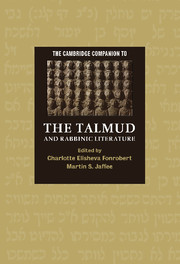Book contents
- Frontmatter
- Introduction: The Talmud, Rabbinic Literature, and Jewish Culture
- Part I: The Conditions of Rabbinic Literary Activity
- Part II: The Genres of Rabbinic Literary Composition
- Part III: Hermeneutical Frames for Interpreting Rabbinic Literature
- 11 The “Other” in Rabbinic Literature
- 12 Regulating the Human Body: Rabbinic Legal Discourse and the Making of Jewish Gender
- 13 Rabbinic Historiography and Representations of the Past
- 14 Rabbinical Ethical Formation and the Formation of Rabbinic Ethical Compilations
- 15 Hellenism in Jewish Babylonia
- Bibliography
- Index
- Source Index
- Series List
14 - Rabbinical Ethical Formation and the Formation of Rabbinic Ethical Compilations
from Part III: - Hermeneutical Frames for Interpreting Rabbinic Literature
Published online by Cambridge University Press: 28 November 2007
- Frontmatter
- Introduction: The Talmud, Rabbinic Literature, and Jewish Culture
- Part I: The Conditions of Rabbinic Literary Activity
- Part II: The Genres of Rabbinic Literary Composition
- Part III: Hermeneutical Frames for Interpreting Rabbinic Literature
- 11 The “Other” in Rabbinic Literature
- 12 Regulating the Human Body: Rabbinic Legal Discourse and the Making of Jewish Gender
- 13 Rabbinic Historiography and Representations of the Past
- 14 Rabbinical Ethical Formation and the Formation of Rabbinic Ethical Compilations
- 15 Hellenism in Jewish Babylonia
- Bibliography
- Index
- Source Index
- Series List
Summary
In the rabbinic communities of Late Antiquity, the study of texts was framed as not only a process of mastering information but also an intrinsic element in the development of the disciple's character. The student was to shape desires and impulses through the guidance of teachers, and the teacher's role, in turn, was to convey, represent, and embody the models of inspiring sages from the past. The material was performed in a context of teaching and learning - spoken, heard, read, and written - where its internalization and creative appropriation could be a key element in the transformation of a student into a cultivated member of the rabbinic movement. Most all of rabbinic literature has ethical or moral dimensions, but some texts reveal a particular focus upon ideal comportment and internal states of mind and sentiment.
A prominent feature of rabbinic ethical literature is that it is not only descriptive but also prescriptive. The sources portray the workings of emotions and desires as well as the details of sagacious behavior, and they also address the reader directly and convey values. Studying the textual sources that are central to the formation of rabbinic character, then, requires us to attend closely to the genres and styles of expression in the literature. This essay will begin with an overview of key themes in rabbinic ethics, but the bulk of the discussion concerns various forms of rabbinic instruction imbedded in the literature. After summarizing features of the distinctly ethical anthologies, I will present exemplary cases illustrating a few of the many ways that ethical teaching emerges and develops through maxims, exegesis, parables, and narratives.
- Type
- Chapter
- Information
- The Cambridge Companion to the Talmud and Rabbinic Literature , pp. 313 - 335Publisher: Cambridge University PressPrint publication year: 2007
- 3
- Cited by

